
The compact disc (CD) is a digital optical disc data storage format that was co-developed by Philips and Sony to store and play digital audio recordings. It uses the Compact Disc Digital Audio format which typically provides 74 minutes of audio on a disc. In later years, the compact disc was adapted for non-audio computer data storage purposes as CD-ROM and its derivatives. First released in Japan in October 1982, the CD was the second optical disc technology to be invented, after the much larger LaserDisc (LD). By 2007, 200 billion CDs had been sold worldwide.
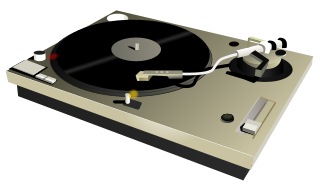
A phonograph, later called a gramophone, and since the 1940s a record player, or more recently a turntable, is a device for the mechanical and analogue reproduction of recorded sound. The sound vibration waveforms are recorded as corresponding physical deviations of a helical or spiral groove engraved, etched, incised, or impressed into the surface of a rotating cylinder or disc, called a "record". To recreate the sound, the surface is similarly rotated while a playback stylus traces the groove and is therefore vibrated by it, faintly reproducing the recorded sound. In early acoustic phonographs, the stylus vibrated a diaphragm that produced sound waves coupled to the open air through a flaring horn, or directly to the listener's ears through stethoscope-type earphones.

The Compact Cassette, also commonly called a cassette tape, audio cassette, or simply tape or cassette, is an analog magnetic tape recording format for audio recording and playback. Invented by Lou Ottens and his team at the Dutch company Philips, the Compact Cassette was released in August 1963.

An audio tape recorder, also known as a tape deck, tape player or tape machine or simply a tape recorder, is a sound recording and reproduction device that records and plays back sounds usually using magnetic tape for storage. In its present-day form, it records a fluctuating signal by moving the tape across a tape head that polarizes the magnetic domains in the tape in proportion to the audio signal. Tape-recording devices include the reel-to-reel tape deck and the cassette deck, which uses a cassette for storage.
A cassette deck is a type of tape machine for playing and recording audio cassettes that does not have a built-in power amplifier or speakers, and serves primarily as a transport. It can be a part of an automotive entertainment system, a part of a portable audio system or a part of a home component system. In the latter case, it is also called a component cassette deck or just a component deck.
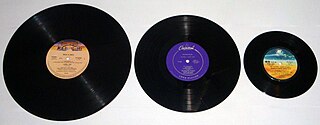
A phonograph record or a vinyl record is an analog sound storage medium in the form of a flat disc with an inscribed, modulated spiral groove. The groove usually starts near the outside edge and ends near the center of the disc. The stored sound information is made audible by playing the record on a phonograph.
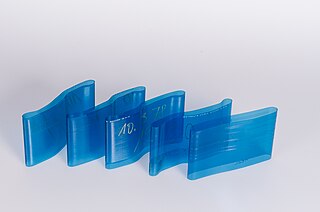
The Dictabelt, in early years and much less commonly also called a Memobelt, is an analog audio recording medium commercially introduced by the American Dictaphone company in 1947. Having been intended for recording dictation and other speech for later transcription, it is a write-once-read-many medium consisting of a 5-mil (0.13 mm) thick transparent vinyl plastic belt 3.5 inches (89 mm) wide and 12 inches (300 mm) around. The belt is loaded onto a pair of metal cylinders, put under tension, then rotated like a tank tread. It is inscribed with an audio-signal-modulated helical groove by a stylus which is slowly moved across the rotating belt. Unlike the stylus of a record cutter, the Dictabelt stylus is blunt and in recording mode it simply impresses a groove into the plastic rather than engraving it and throwing off a thread of waste material. The Dictabelt system was popular, and by 1952, made up 90% of Dictaphone's sales.

dbx is a family of noise reduction systems developed by the company of the same name. The most common implementations are dbx Type I and dbx Type II for analog tape recording and, less commonly, vinyl LPs. A separate implementation, known as dbx-TV, is part of the MTS system used to provide stereo sound to North American and certain other TV systems. The company, dbx, Inc., was also involved with Dynamic Noise Reduction (DNR) systems.

An album is a collection of audio recordings issued on a medium such as compact disc (CD), vinyl (record), audio tape, or digital. Albums of recorded sound were developed in the early 20th century as individual 78 rpm records (78s) collected in a bound book resembling a photo album; this format evolved after 1948 into single vinyl long-playing (LP) records played at 33+1⁄3 rpm.

The overwhelming majority of records manufactured have been of certain sizes, playback speeds, and appearance. However, since the commercial adoption of the gramophone record, a wide variety of records have also been produced that do not fall into these categories, and they have served a variety of purposes.
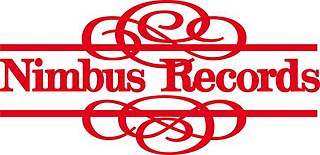
Nimbus Records is a British record company based at Wyastone Leys, Ganarew, Herefordshire. They specialise in classical music recordings and were the first company in the UK to produce compact discs.

Sound recording and reproduction is the electrical, mechanical, electronic, or digital inscription and re-creation of sound waves, such as spoken voice, singing, instrumental music, or sound effects. The two main classes of sound recording technology are analog recording and digital recording.
The history of sound recording - which has progressed in waves, driven by the invention and commercial introduction of new technologies — can be roughly divided into four main periods:

The LP is an analog sound storage medium, specifically a phonograph record format characterized by: a speed of 33+1⁄3 rpm; a 12- or 10-inch diameter; use of the "microgroove" groove specification; and a vinyl composition disk. Introduced by Columbia Records in 1948, it was soon adopted as a new standard by the entire US record industry and, apart from a few relatively minor refinements and the important later addition of stereophonic sound in 1957, it remained the standard format for record albums during a period in popular music known as the album era. LP was originally a trademark of Columbia and competed against the smaller 7-inch sized "45" or "single" format by RCA Victor, eventually ending up on top. Today in the vinyl revival era, a large majority of records are based on the LP format and hence the LP name continues to be in use today to refer to new records.

The conservation and restoration of vinyl discs refers to the preventive measures taken to defend against damage and slow degradation, and to maintain fidelity of singles, 12" singles, EP’s, and LP’s in 45 or 33⅓ rpm 10" disc recordings.
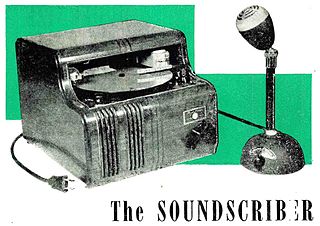
SoundScriber is a dictation machine introduced in 1945 by The SoundScriber Corp.. It records sound with a groove embossed into soft vinyl discs with a stylus. Similar competing recording technologies are the Gray Audograph and Dictaphone DictaBelt. The machine can record 15 minutes of dictation on each side of a thin (.01-inch) flexible 6-inch vinyl disc spinning at a rate of 33+1⁄3 RPM, at a density of 200 grooves per inch. The discs originally cost about 10 cents each. The machine has two tonearms: a recording arm driven by a worm gear that creates the groove with a diamond stylus, and a pickup arm with a sapphire stylus for playback. A foot-operated playback/pause—and-reverse switch is used for transcribing.

A dictation machine is a sound recording device most commonly used to record speech for playback or to be typed into print. It includes digital voice recorders and tape recorder.
In the field of audio recording, an aluminum disc is a phonograph record made of bare aluminum, a medium introduced in the late 1920s for making one-off recordings. Although sometimes used for making amateur studio or home recordings or in coin-operated "record-your-voice" booths at fairs and arcades, during the first half of the 1930s bare aluminum discs were primarily used to record radio broadcasts for the private transcription disc archives of performers or sponsors.

Electric music technology refers to musical instruments and recording devices that use electrical circuits, which are often combined with mechanical technologies. Examples of electric musical instruments include the electro-mechanical electric piano, the electric guitar, the electro-mechanical Hammond organ and the electric bass. All of these electric instruments do not produce a sound that is audible by the performer or audience in a performance setting unless they are connected to instrument amplifiers and loudspeaker cabinets, which made them sound loud enough for performers and the audience to hear. Amplifiers and loudspeakers are separate from the instrument in the case of the electric guitar, electric bass and some electric organs and most electric pianos. Some electric organs and electric pianos include the amplifier and speaker cabinet within the main housing for the instrument.

IBM Electric Typewriter Division manufactured and sold dictation equipment from 1960 until 1982. This was a totally new product area for IBM who had no previous experience in this field. The Typewriter Division entered the market to meet Thomas J. Watson Jr.'s goal to double their business size every five years, which given their dominance in the electric typewriter market, meant they needed to offer a wider variety of product types. IBMs goal with dictation machines was to provide efficient, easy to use products that offered high audio fidelity. However while dictation machines were complementary with IBMs typewriter product range, it did require IBMs Sales reps to learn how to sell a totally different product. This was because many executives were reluctant to use dictation machines. IBM was the market leader by 1965, outselling their biggest competitor Dictaphone and driving Ediphone out of the market. Unit sales peaked in 1969 at 98,000 units, which was roughly a 33% market share.


















